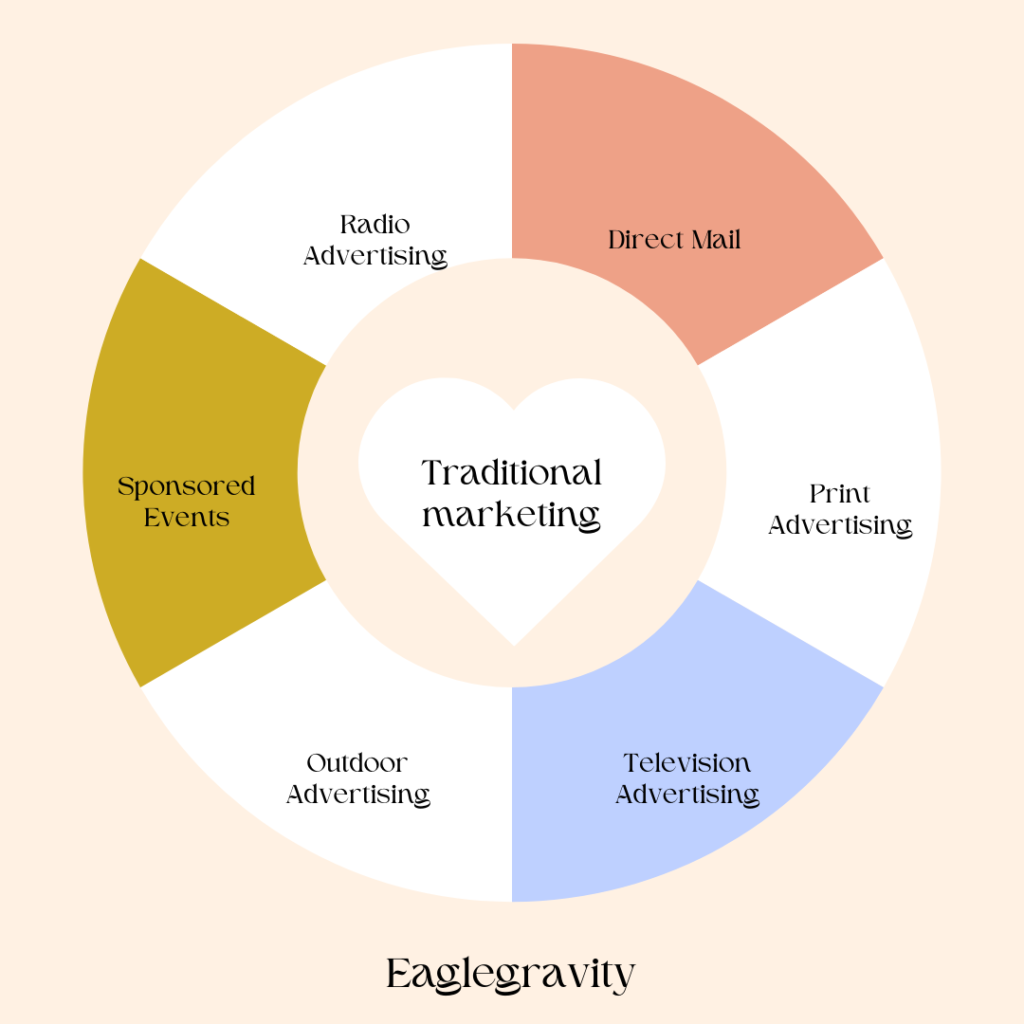
Broadcast Marketing

Direct Mail Marketing

Telemarketing

Outdoor MarketinWord-of-Mouth Marketing

Promotional Marketing

Traditional marketing refers to any form of marketing that is established before the advent of the internet and digital technologies. It encompasses a variety of methods, including print advertisements, television commercials, radio spots, direct mail, and outdoor advertising such as billboards. Despite the rapid rise of digital marketing in recent years, traditional marketing remains significant in reaching diverse audiences and crafting brand recognition. Many consumers still rely on traditional media for information, making these methods relevant in a comprehensive marketing strategy.
The history of traditional marketing is rich and varied. It began with direct mail campaigns and printed flyers, evolving through the introduction of radio and television, which allowed brands to reach broader markets. The modern advertising landscape has its roots tracing back to the early 20th century, when businesses discovered that strategic placements in newspapers and magazines could lead to increased sales and brand loyalty. Over the decades, traditional marketing has adapted to shifts in consumer behavior and technology, maintaining its place alongside newer digital strategies.
One of the primary benefits of incorporating traditional marketing techniques is the ability to create a tangible connection with consumers. Physical advertisements allow for a noticeable presence in the community and often lead to higher levels of trust. Additionally, traditional marketing can enhance brand credibility by utilizing well-known and widely accepted media channels. Furthermore, many people still respond positively to traditional marketing methods, which can yield effective results, particularly among specific demographics. By blending traditional and digital marketing strategies, businesses can create a holistic approach that effectively reaches a broader audience and fosters sustainable growth.
Types of Traditional Marketing:

Traditional marketing encompasses a range of strategies that have been utilized across various industries to reach consumers effectively. These methods primarily rely on offline channels to deliver messages and promote products or services. Below are some significant types of traditional marketing:
Print Advertising: This form of marketing includes newspapers, magazines, brochures, and flyers. Print advertising is particularly effective for targeting specific demographics based on publication circulation. Advertisers can leverage high-quality visuals and written content to convey their messages, making it a durable option that consumers can engage with at their convenience.
Direct Mail: Direct mail campaigns involve sending promotional materials directly to potential customers via postal mail. This marketing approach helps create a one-on-one connection with the target audience. The tangible nature of direct mail can lead to higher engagement rates, particularly when personalized with the recipient’s name or tailored messages, enhancing the likelihood of conversion.
Television Advertising: Television is a powerful medium for traditional marketing, given its extensive reach. Advertisers can create compelling audiovisual content that resonates emotionally with viewers. Commercials, product placements, and sponsored segments are common formats found in TV advertising. Furthermore, companies can strategically time their ads during popular shows to maximize viewer engagement.
Radio Advertising: Radio marketing utilizes audio content to promote products and services. Its advantage lies in the ability to reach audiences during commutes or at home. Advertisements can be tailored in terms of length and style, allowing for both informative and entertaining messages. This form of advertising is particularly effective for targeting local markets.
Outdoor Advertising: Outdoor marketing includes billboards, transit advertising, and posters in public spaces. This type of marketing offers high visibility and can effectively capture the attention of passersby. Outdoor advertisements often rely on concise messaging paired with bold visuals, making them easily digestible in a brief glance.
Sponsored Events: Marketers can also build brand recognition through sponsored events such as concerts, sports events, or community fairs. By aligning with popular activities, brands can engage directly with their target audience. Sponsorship provides exposure and enhances brand reputation by associating with positive experiences.
Cost-effective Traditional Marketing Strategies:
For small businesses and startups, implementing cost-effective traditional marketing strategies can be instrumental in reaching target audiences without incurring significant costs. One of the simplest yet effective methods is advertising in local newspapers. This form of marketing allows companies to connect with their community directly, which is particularly beneficial for businesses with a local customer base. A well-designed ad or press release can capture attention and generate interest in products or services while maintaining a modest budget.
Community bulletin boards offer another affordable avenue for promotion. Many towns have centralized locations, such as libraries or community centers, where businesses can post flyers or announcements free of charge or for a nominal fee. By utilizing these boards, startups can effectively spread the word about upcoming events, promotions, or new offerings. It is crucial to ensure that the design is appealing and the messaging is clear, as this will significantly enhance visibility and encourage engagement.
Grassroots events can also serve as a powerful marketing strategy without requiring extensive financial investment. Organizing or participating in community events fosters relationships with local customers and enhances brand visibility. For example, a small business might sponsor a local sports team or host a workshop related to its industry. Such initiatives not only promote the business but also demonstrate its commitment to the community, creating goodwill and fostering customer loyalty.
Maximizing the impact of these strategies involves creativity. By encouraging customer testimonials and leveraging word-of-mouth referrals, small businesses can amplify their reach. Engaging with customers on social media, while using traditional marketing methods, creates a more comprehensive marketing strategy. Ultimately, combining local advertising with community-focused initiatives provides startups with a robust framework for effective traditional marketing without straining budgets.
High-budget Traditional Marketing Approaches:
High-budget traditional marketing strategies are often employed by large corporations seeking to enhance their visibility and reach a wider audience. These powerful tactics encompass national television campaigns, significant sponsorships, and large-scale print advertising, all designed to create new customer bases and increase brand awareness effectively.
National television campaigns stand out as one of the most impactful methods in traditional marketing. By leveraging prime airtime slots, brands can deliver their messages to millions of viewers simultaneously. The visual and auditory elements of television ads help create memorable associations with products, fostering consumer recognition and loyalty. Large corporations often allocate substantial budgets to develop high-quality content that resonates emotionally with their target audience, ensuring that their advertisements remain top-of-mind.
Another effective strategy involves major sponsorships. These sponsorships can range from events such as sports teams to festivals and charitable initiatives. By aligning with popular cultural events, brands can tap into the existing enthusiasm of attendees or viewers, thereby expanding their reach and enhancing their reputation. This association can evoke positive emotions and strengthen brand credibility, as consumers often appreciate companies that support their favorite causes or events.
Large-scale print advertising is also a critical component of high-budget traditional marketing approaches. Newspapers, magazines, and billboards offer tangible and visual platforms for brands to showcase their products. While digital marketing continues to rise, print media retains its relevance, especially among specific demographics that prefer traditional formats. Investing in prominent placements ensures that brands are visible in the right contexts, ultimately driving traffic to their websites or physical locations.
In conclusion, high-budget traditional marketing strategies play a vital role in large corporations’ efforts to build brand awareness and customer loyalty. By employing a mix of television campaigns, sponsorships, and print advertising, businesses can effectively engage with wider audiences and create lasting connections.
Comparison: High-budget vs. Low-budget Traditional Marketing:
In the realm of traditional marketing, businesses often face the pivotal decision of selecting between high-budget and low-budget strategies. Each approach presents unique advantages and challenges that can significantly impact the effectiveness of marketing efforts. Understanding these differences is crucial for businesses aiming to align their marketing strategies with financial resources and goals.
High-budget traditional marketing strategies typically involve extensive financial investment in channels such as television, radio, and large-scale print advertising. The primary benefit of this approach is the potential for wider reach and greater visibility, allowing businesses to engage a larger audience. High-budget campaigns often feature professional productions, high-quality creative content, and prominent placements, which can enhance brand perception and credibility. However, the downside lies in the elevated risk associated with significant financial commitment; if the campaign does not yield the anticipated return on investment, the losses can be substantial.
Conversely, low-budget traditional marketing makes use of cost-effective channels and tactics for promotion. This could include local newspaper ads, community bulletin boards, or grassroots campaigns. One of the principal advantages of low-budget strategies is the minimal financial risk, allowing businesses to test multiple approaches without heavy investment. Additionally, low-budget marketing often fosters creativity, encouraging businesses to think outside the box in terms of engagement and outreach. However, it may also limit reach and visibility compared to more costly campaigns, potentially affecting brand awareness in competitive markets.
Ultimately, the decision between high-budget and low-budget traditional marketing strategies hinges on individual business objectives, target audience, and available resources. Businesses must evaluate their specific goals and financial capabilities to determine which strategy will most effectively contribute to their overall marketing success.
Integrating Traditional and Digital Marketing:
In today’s rapidly evolving marketplace, the integration of traditional and digital marketing strategies has become an essential component for achieving comprehensive business success. By embracing a hybrid marketing approach, organizations can leverage the strengths of both realms, maximizing their reach and enhancing overall effectiveness. Traditional marketing, which encompasses print media, television, and radio, continues to hold significant influence in reaching segments of the population that prefer conventional channels. At the same time, digital marketing offers unparalleled targeting capabilities, real-time tracking, and engagement opportunities that are indispensable in modern consumer behavior.
The synergy between these two marketing approaches can be harnessed to create cohesive campaigns that resonate with a broader audience. For example, a television advertisement can be complemented by a social media campaign that encourages viewers to engage online, share their experiences, or visit a dedicated website. By integrating these tactics, businesses can create a consistent message across various platforms, reinforcing brand recognition and fostering deeper connections with consumers. Furthermore, data obtained from digital marketing can inform traditional marketing strategies, guiding the development of compelling content or more effective advertising placements.
To successfully blend traditional marketing with digital efforts, companies should consider employing a multi-channel strategy that identifies and utilizes key touchpoints throughout the consumer journey. This could involve tactics such as using QR codes in print materials to drive traffic to a website, or utilizing social media to share exclusive promotions tied to traditional media advertising. By providing multiple avenues for engagement, brands can enhance user experience, ensuring that all marketing efforts work in harmony to yield optimal results. Ultimately, the integration of traditional and digital marketing not only enhances visibility but also cultivates a more comprehensive understanding of consumer preferences, paving the way for innovative and effective marketing strategies moving forward.
Measuring the Success of Traditional Marketing Campaigns:
Measuring the success of traditional marketing campaigns is essential for evaluating their effectiveness and optimizing future strategies. Various Key Performance Indicators (KPIs) provide marketers with quantifiable data to assess their initiatives’ impact. One primary method involves tracking sales figures before, during, and after the campaign launch. This analysis helps identify any direct correlation between marketing efforts and revenue generation.
Surveys are another crucial tool for evaluating traditional marketing campaigns. By conducting customer surveys, businesses can gather feedback on brand awareness, customer perception, and overall satisfaction. Such insights can reveal the strengths and weaknesses of the marketing strategies deployed. Additionally, pre- and post-campaign surveys can efficiently gauge shifts in consumer attitudes and purchasing behaviors due to marketing initiatives.
Return on Investment (ROI) analysis provides a comprehensive overview of a campaign’s financial efficiency. By comparing the costs associated with running the campaign against the revenue it generated, marketers can determine the ROI ratio. A positive ROI indicates that the traditional marketing campaign was financially successful, whereas a negative ROI suggests the need for reevaluation and strategy adjustments.
Other metrics may include reach and frequency measurements, which quantify how many people were exposed to a campaign and how often. Tracking these metrics can facilitate a better understanding of the campaign’s overall exposure and engagement levels. Additionally, businesses can utilize tools such as call tracking, coupon codes, and unique URLs to create a more granular analysis of customer responses and interactions with traditional marketing channels.
By carefully evaluating these various factors, marketers can appraise the effectiveness of their traditional marketing campaigns and make informed decisions for future initiatives, ensuring continued growth and success.
Common Mistakes in Traditional Marketing and How to Avoid Them:
Businesses often encounter various pitfalls when implementing traditional marketing strategies, which can hinder their success and diminish return on investment. One common mistake is failing to define and understand the target audience accurately. Without proper audience segmentation, marketing efforts may miss the mark, leading to ineffective campaigns and wasted resources. To avoid this, businesses should invest time in market research to identify demographics, preferences, and behaviors, ensuring that marketing materials resonate with the intended audience.
Another prevalent error is neglecting the importance of message consistency across different platforms. When the marketing message varies from one medium to another, it can confuse potential customers and dilute brand identity. Companies should maintain a coherent narrative throughout their advertising endeavors—whether through print, radio, television, or events. Establishing and adhering to a style guide can help in sustaining consistency and strengthening brand recognition.
Many businesses also overlook the value of tracking and analyzing campaign performance. Traditional marketing can render it challenging to measure success quantitatively. However, integrating methods such as customer feedback, sales data analysis, and follow-up surveys allows organizations to assess effectiveness accurately. This ongoing evaluation helps in fine-tuning strategies and reallocating resources to higher-performing channels.
Cost is another critical factor that can lead to marketing missteps. Businesses sometimes invest heavily in either underperforming advertisements or untested strategies without proper testing. It is advisable to start small and scale successful tactics gradually, ensuring that expenditures align with returns from traditional marketing efforts.
By avoiding these common mistakes—such as misidentifying the target market, lacking message consistency, neglecting performance tracking, and overspending—businesses can enhance their traditional marketing strategies, leading to measurable success and improved brand visibility.
Case Studies: Successful Traditional Marketing Campaigns:
Examining traditional marketing campaigns from renowned brands provides invaluable insights into successful strategies. One notable example is Coca-Cola’s “Share a Coke” campaign. Launched in Australia in 2011, this campaign personalized Coca-Cola bottles with popular names. By inviting consumers to find and share bottles featuring their names, Coca-Cola successfully tapped into the emotional aspects of personalization. The result was a significant increase in sales, with the campaign generating a 4% uplift in consumption. This initiative demonstrated the power of emotional connections and personal engagement in traditional marketing.
Another compelling case is the “Just Do It” campaign by Nike. This slogan emerged in 1988 and has since become synonymous with the brand. Its effectiveness lies in its ability to inspire and empower individuals across different demographics to push their limits. Nike’s use of powerful imagery combined with motivational storytelling in print ads has helped cement its position in the athletic wear market. The campaign’s longevity speaks to the timeless appeal of a strong, motivational message, showcasing that traditional marketing can resonate over decades.
The “Whassup?” campaign by Budweiser is also worth mentioning. Launched in 1999, it featured a group of friends who greeted each other with the humorous phrase “Whassup?” This simple, relatable concept captured the attention of various audiences, leading to significant brand recognition and an approximate 20% increase in sales. By utilizing humor and relatability, Budweiser effectively engaged consumers, demonstrating how traditional marketing can create lasting brand associations.
These case studies showcase the importance of creativity, relatability, and emotional connection in traditional marketing campaigns. By understanding the elements that contributed to their success, future campaigns can learn valuable lessons in engaging audiences through effective strategies.

